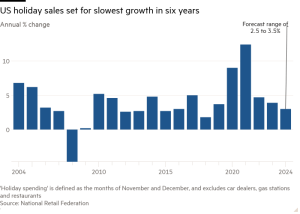Beijing pledges further boosts to ETF industry
Chinese authorities have announced plans to step up state investment in the country’s rapidly expanding exchange traded fund industry and grow the number of ETFs investing in the tech sector and small and medium-size enterprises.
The plans are part of a new stimulus package unveiled by China’s central bank and top financial and securities regulators on September 24, as the government strives to reignite growth and bolster the flagging stock markets in the world’s second-largest economy.
In a press briefing, Pan Gongsheng, governor of the People’s Bank of China, announced measures such as cuts to its benchmark interest rate, plans to shore up China’s beleaguered property market, as well as at least Rmb800bn ($113.76bn) of liquidity support to prop up the local equities market.
Speaking at the same press conference, Wu Qing, the head of the China Securities Regulatory Commission, announced plans to encourage the launch of more small and mid-cap equities ETFs, especially those that will track China’s Growth Enterprise Market and Sci-Tech Innovation Board.
This move is intended “to better serve investors and national strategy”, he added.
The Shanghai Stock Exchange‘s Nasdaq-style science and technology board, referred to as the Star Market, was launched in 2019 to help funnel more capital towards China’s technology sectors and emerging companies.
There are two main indices tracking China’s science and technology board, the SSE Star 50 and SSE Star 100. Only five ETFs track the SSE Star 50 index, while another seven track the SSE Star 100 index, according to Wind data.
Wu referenced the 10 “popular” new CSI A500 ETFs that have all concluded initial fundraising in the past week after scoring rapid one-day approval from the regulator early this month.
Seven of the new CSI 500 ETFs from firms including Harvest Fund Management and JPMorgan Asset Management have pulled in at least Rmb2bn each. The CSI A500 Index was launched in China on September 23.
“We will further optimise the registration of equities fund products, promote the innovation of indexed products such as broad-based ETFs, and launch more mid and small-cap ETF fund products in due course,” Wu said.
Jia Zhi, managing director of the asset management department at ChinaLin Securities, told Ignites Asia he believed the latest regulatory push could help boost investor confidence in the ETF market and into smaller-cap fund products over the longer term.
“But the lack of liquidity in mid and small-cap ETFs and investors’ relatively short patience in generating returns will limit the demand for such kind of products,” he added.
Over the past 12 months, China’s “national team” of sovereign wealth funds, most prominently Central Huijin Investment, have ploughed billions of renminbi into broad-based ETF tracking the CSI 300 Index in a bid to boost the A-share market and rekindle investor confidence.
At the press conference, Wu, who was appointed to run the securities watchdog in February, said the CSRC would continue to work with Central Huijin to “increase its holdings and expand its investment scope” in long and midterm investment funds.
He added that Central Huijin has already played a “very important role in stabilising the market and boosting confidence” and that many investment institutions and research institutions at home and abroad also believe that the valuation of the A-share market is at a historical low.
In the first half of the year, Central Huijin injected over Rmb330bn into CSI 300 ETFs run by Huatai-PineBridge Fund Management, E Fund Management, Harvest Fund Management and China Asset Management, as well as China AMC’s SSE 50 ETF.
By the end of the second quarter, Central Huijin’s holdings in these five broad-based ETFs had a total market value exceeding Rmb430bn.
This massive injection of capital has helped China’s ETF industry grow from Rmb1.39tn at the start of 2023 to Rmb2.27tn at the end of June this year.
During the press briefing, PBoC head Pan also laid out plans to create a “swap facility” for securities firms, fund companies and insurance firms to tap liquidity from the central bank via asset pledging, with Rmb500bn earmarked for investment in stock market in the first phase of the scheme.
Pledged assets under the swap facility will include bonds, equities ETFs and CSI 300 index stocks, and the liquidity will include government bonds, central banknotes.
Pan said the move would significantly boost the ability of financial institutions to access capital and hold stocks.
The CSRC’s Wu also said the regulator would continue its reforms of fees in the public funds industry.
The CSRC in July last year commenced its long-term industry fee reforms, by instructing fund companies to cut management fees for onshore mutual funds.
It then introduced new rules to reduce the trading commissions that fund firms pay to securities houses, and plans to overhaul fund fee disclosures and cap trailer fees that asset managers pay to salespeople.
Wu, an ex-mayor of Shanghai who is nicknamed China’s “Broker Butcher” after he forced the closure of a quarter of the country’s securities dealers in the 2000s, also laid out the reforms he is pursuing to overhaul the local funds industry.
“The focus will be to urge fund companies to further correct their business philosophy, adhere to investor return orientation, focus on improving investment research and service capabilities, create more products that meet the needs of the people, and strive to create long-term returns for investors,” Wu said.
Since Wu’s appointment as head of the CSRC earlier this year, Chinese fund firms have faced months of on-site inspections by local branches of the securities regulator and the National Audit Office, as authorities seek to extend governance oversight and crack down on misconduct in the industry.
#Beijing #pledges #boosts #ETF #industry





